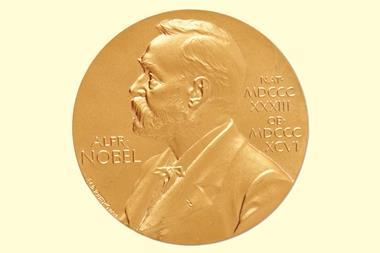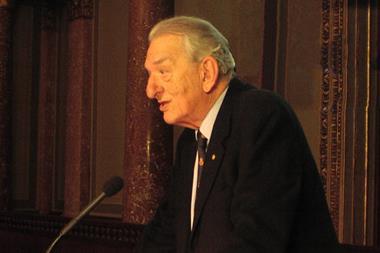Mark Peplow celebrates decades of debate about the structure of the 2-norbornyl cation
For Herbert Brown, it had become a ‘holy war’. It was 1977, and the Purdue University chemist had already served over 15 years on the frontline of a battle about the structure of the 2-norbornyl cation. Now it was time for his definitive salvo: The nonclassical ion problem, an entire book devoted to the debate about this ephemeral reaction intermediate.1
‘One would have thought that the application of careful experiments and intelligent thought to the problem would lead rapidly to a clear conclusion,’ he wrote in its preface, adding drily: ‘This has not been the case.’
In July, the last, incontrovertible piece of evidence finally arrived: an unambiguous crystal structure of the capricious cation. It crowns a chemical odyssey that has spanned six decades, and makes for a fascinating case study in the history of chemistry.
Exotic beast
The controversy involved some of the biggest names in chemistry, but at its heart were Brown; Saul Winstein of the University of California, Los Angeles (UCLA); and George Olah, now at the University of Southern California. They were trying to explain a puzzling reaction of 2-norbornyl brosylate, in which the brosylate group can have an endo or exo position. A substitution reaction replacing brosylate with an acyl group gives the same product for both isomers: exo-2-norbornyl acetate – although the exo starting material reacts much faster.
Everyone agreed that the first, rate-limiting, step must involve the departure of the brosylate group to produce a symmetrical norbornyl cation. But what was the cation’s structure, and why did the reaction rates differ?
In 1949, Winstein suggested a ‘non-classical’ cation, featuring a pair of delocalised electrons smeared between three carbon atoms, which helped the exo brosylate to leave and then favoured the exo product.2 It was a popular idea, and non-classical cations started popping up in papers throughout the 1950s.
These battles of will help to give chemistry its vitality, able to argue through its problems with all the verve of a fractious family
From the early 1960s, though, Brown began a campaign against this exotic beast with its devilish five-coordinate carbon atoms. Why invoke a strange form of bonding over more conventional reasoning? Brown preferred a pair of classical trivalent carbocations that rapidly interconverted, and put the difference in reaction rates down to steric effects.3
By the 1980s, Olah’s NMR studies had convinced most chemists that Winstein was right.4 The crystal structures that now confirm his proposal may be the icing on the cake, but it took a truly heroic effort to acquire atomic snapshots of the carbocation at 40K.5
Everyone’s a winner
Those outside the field may be baffled by decades of argument about where to draw a couple of bonds. As William Goodwin at the University of South Florida points out in a recent analysis of the affair, resolving the debate was not even crucial to progress in carbocation chemistry, which was romping along quite happily at the time.6 Was the controversy just an esoteric sideshow?
Far from it. Each round of the debate forced the protagonists to raise their game, bringing ever-more refined analytical techniques to the discussion. It showed that single carbon–carbon bonds could donate electrons to strong electrophiles, delivering new insights into reaction mechanisms. And the two bonding descriptions offered different predictions about how molecules would react in the real world.7 It was important to find the answer.
The 2-norbornyl cation was also a lightning rod for much broader discussions about how chemists represent molecules.8 Lewis structures are a vital tool for chemists because they are quick and intuitive to draw. But even by the 1940s, it was a struggle to reconcile these pictures with the growing knowledge of electron delocalisation.
Brown and Winstein were both trying to account for delocalisation within these imperfect but indispensible diagrams, leading to differing conclusions from the same evidence. Although molecular orbital theory offered a more quantitative, quantum mechanical view of bonding, the sheer usefulness of Lewis structures was simply more important than whether they were actually true.
I don’t think that we should lament that compromise. Fooling ourselves that any of these bonding approximations are real would be a mistake, of course, but by challenging and refining them we gain a better grasp of how the universe works.
The saga also highlights the importance of the human factor in science. Science is sometimes presented as an objective, dispassionate pursuit that makes progress by steadily verifying or refuting hypotheses. But science is so much more than an algorithm.
The tenacity of these particular protagonists was a key reason why the controversy rumbled on for so long, and the debate was not won with a new data point, or this latest crystal structure, but once a critical mass of other chemists had made their minds up.
These sociological aspects to scientific investigation are not flaws. Even stubbornness and rivalry can be beneficial when they force opponents to construct the strongest arguments possible in order to persuade their peers. These battles of will help to give chemistry its vitality, able to argue through its problems with all the verve of a fractious family.
One could say that the 2-norbornyl crystal structure proves once and for all that Brown lost the argument. I’d rather conclude that, as a result of the debate, chemistry itself was the winner.
References
1 H Brown, The nonclassical ion problem, 1977, Springer (DOI: 10.1007/978-1-4613-4118-5)
2 S Winstein and D Trifan, J. Am. Chem. Soc., 1949, 71, 2953 (DOI: 10.1021/ja01176a536)
3 H Brown, F Chloupek and M-H Rei, J. Am. Chem. Soc., 1964, 86, 1248 (DOI: 10.1021/ja01060a060)
4 G Olah, G Prakash and M Saunders, Acc. Chem. Res., 1983, 16, 440 (DOI: 10.1021/ar00096a003)
5 F Scholz et al, Science, 2013, DOI: 10.1126/science.1238849
6 W Goodwin, Br. J. Philos. Sci., 2012, DOI: 10.1093/bjps/axs025
7 P Ball, Nature, 2011, 469, 26 (DOI: 10.1038/469026a)
8 S Weininger,Bull. Hist. Chem., 2000, 25, 123 http://bit.ly/12lXxCn












No comments yet